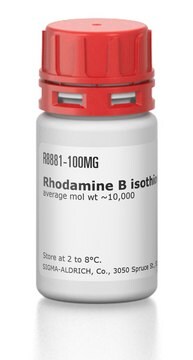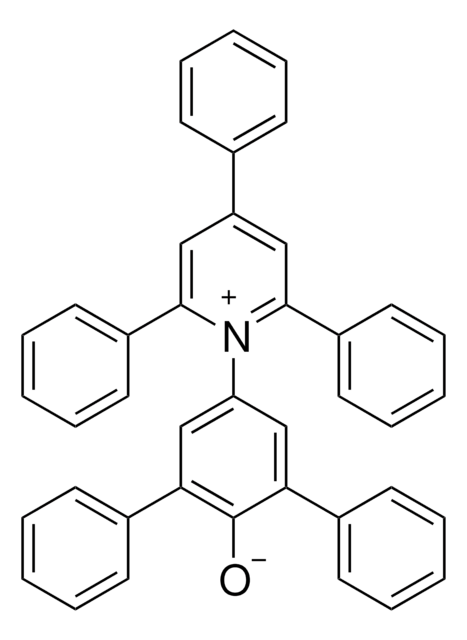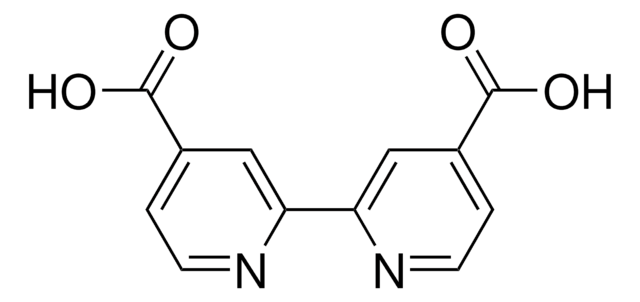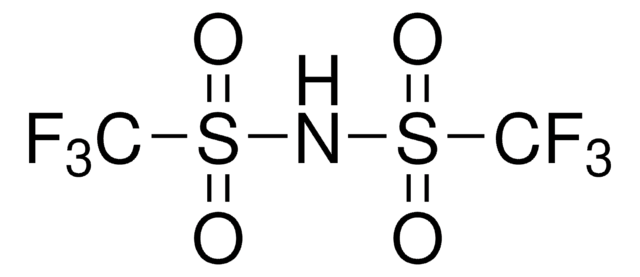791415
K19 Dye
85% (HPLC)
Synonym(e):
Greatcell Solar®, K 19 sensitizer, Ru(4,4-dicarboxylic acid-2,2′-bipyridine)(4,4′-bis(p-hexyloxystyryl)-2,2-bipyridine)(NCS)2
About This Item
Empfohlene Produkte
Assay
85% (HPLC)
Form
powder (black)
mp (Schmelzpunkt)
>300 °C
λmax
536, 357, 311 nm at 0.02 mM in DMF (lit.)
SMILES String
OC(C1=CC(C2=CC(C(O)=O)=CC=N2)=NC=C1)=O.S=C=N[Ru]N=C=S.CCCCCCOC(C=C3)=CC=C3/C=C/C4=CC=NC(C5=NC=CC(/C=C/C6=CC=C(OCCCCCC)C=C6)=C5)=C4
InChI
1S/C38H44N2O2.C12H8N2O4.2CNS.Ru/c1-3-5-7-9-27-41-35-19-15-31(16-20-35)11-13-33-23-25-39-37(29-33)38-30-34(24-26-40-38)14-12-32-17-21-36(22-18-32)42-28-10-8-6-4-2;15-11(16)7-1-3-13-9(5-7)10-6-8(12(17)18)2-4-14-10;2*2-1-3;/h11-26,29-30H,3-10,27-28H2,1-2H3;1-6H,(H,15,16)(H,17,18);;;/q;;2*-1;+2/b13-11+,14-12+;;;;
InChIKey
HBARXZGSEMEPLK-BPSJQPAOSA-N
Allgemeine Beschreibung
Anwendung
Rechtliche Hinweise
Greatcell Solar is a registered trademark of Greatcell Solar Materials Pty Ltd.
Signalwort
Warning
H-Sätze
Gefahreneinstufungen
Eye Irrit. 2 - Skin Irrit. 2 - Skin Sens. 1 - STOT SE 3
Zielorgane
Respiratory system
Lagerklassenschlüssel
11 - Combustible Solids
WGK
WGK 3
Flammpunkt (°F)
Not applicable
Flammpunkt (°C)
Not applicable
Hier finden Sie alle aktuellen Versionen:
Analysenzertifikate (COA)
Die passende Version wird nicht angezeigt?
Wenn Sie eine bestimmte Version benötigen, können Sie anhand der Lot- oder Chargennummer nach einem spezifischen Zertifikat suchen.
Besitzen Sie dieses Produkt bereits?
In der Dokumentenbibliothek finden Sie die Dokumentation zu den Produkten, die Sie kürzlich erworben haben.
Kunden haben sich ebenfalls angesehen
Artikel
While dye sensitization as the basis for color photography has been accepted for a very long time,1 attempts to use this principle for the conversion of solar light to electricity generally had resulted only in very low photocurrents, below 100 nA/cm2.2
Unser Team von Wissenschaftlern verfügt über Erfahrung in allen Forschungsbereichen einschließlich Life Science, Materialwissenschaften, chemischer Synthese, Chromatographie, Analytik und vielen mehr..
Setzen Sie sich mit dem technischen Dienst in Verbindung.

![2-((E)-5-(1,2,3,3a,4,8b-Hexahydro-4-(4-(2,2-diphenylvinyl)-phenyl)-cyclopenta[b]indol-7-yl)-methyl)-3-ethyl-5-(3-carboxymethyl-4-oxo-thazolidin-2-yliden)-rhodanin 98% (HPLC)](/deepweb/assets/sigmaaldrich/product/structures/385/198/55d7638f-f6fb-4715-a568-f1794810f1a5/640/55d7638f-f6fb-4715-a568-f1794810f1a5.png)











